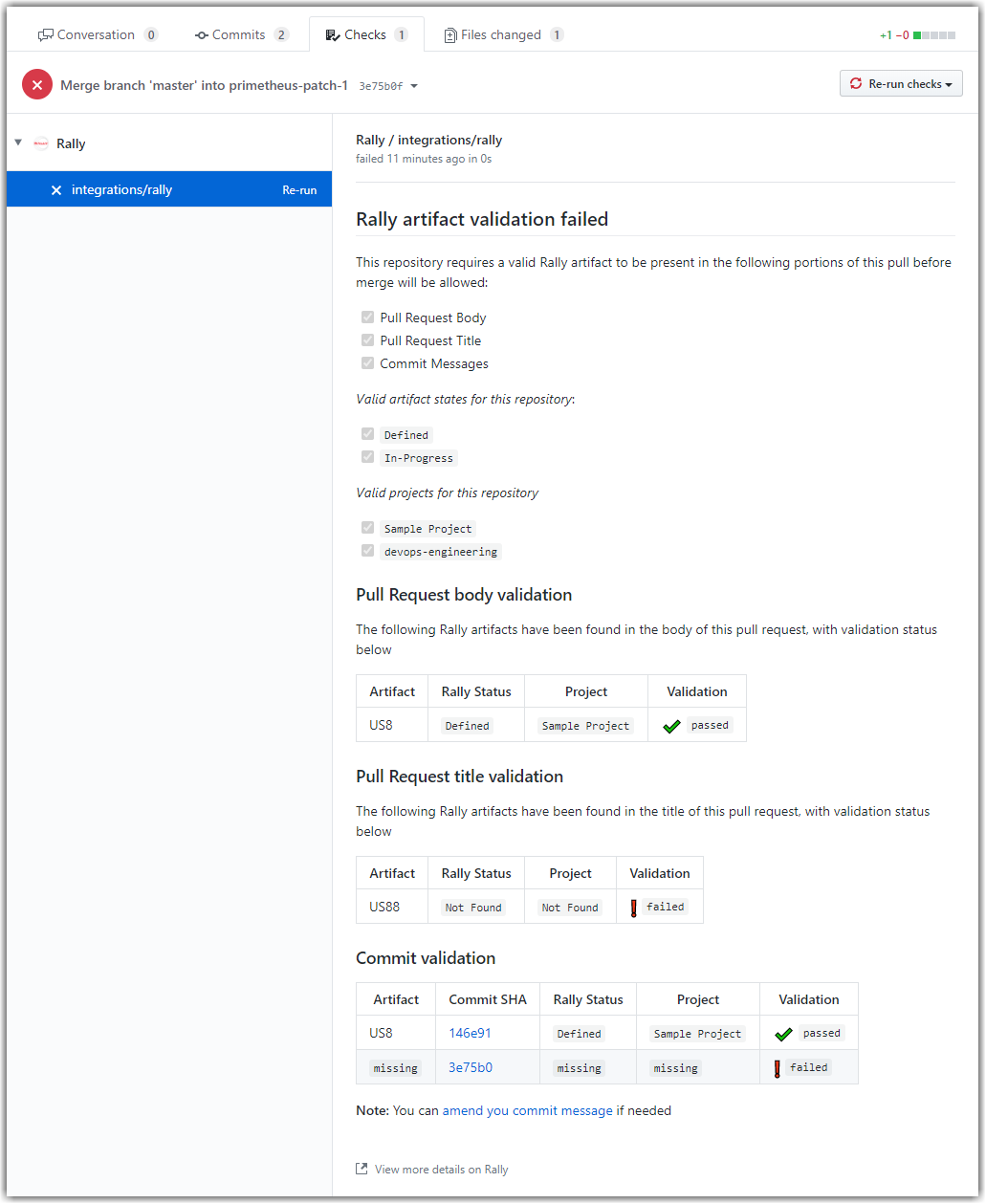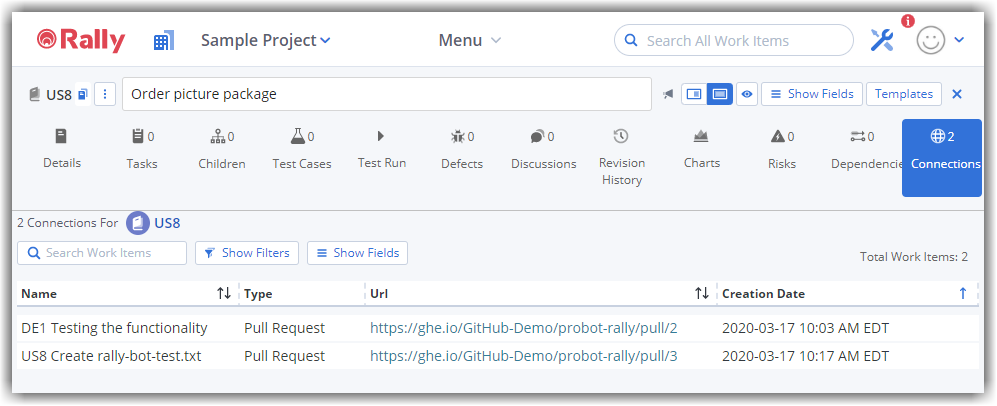updating ownership |
||
|---|---|---|
| .automation | ||
| .github | ||
| docs | ||
| lib | ||
| test | ||
| .env.example | ||
| .gitignore | ||
| Dockerfile | ||
| LICENSE | ||
| docker-compose.yml | ||
| index.js | ||
| jest.config.js | ||
| ownership.yaml | ||
| package-lock.json | ||
| package.json | ||
| rally.yml | ||
.github/README.md
Rally + GitHub
A GitHub App in active development built with Probot that integrates Rally (a project management tool) with GitHub. It can be configured to:
- Check the
titleof a Pull Request for valid Rally artifacts - Check the
bodyof a Pull Request for valid Rally artifacts - Check the
commit messagesof a Pull Request for valid Rally artifacts
The GitHub App will update the Checks API with success/failure as the conditions are met, and provide a detailed report of the artifacts (i.e. defects, user stories) found and their Flow States in Rally.
Get Started
How it Works
Every time a pull request is created or updated, Rally + GitHub will check for the existence of a Rally User Story or Defect in the title, body, or commit messages, and then validate that they are in the correct state in Rally.
---
# Name of the GitHub Check
checksName: integrations/rally
# Check PR Body for Rally story/defect (true | false)
checkPRBody: true
# Check PR Title for Rally story/defect (true | false)
checkPRTitle: true
# Check all commit messages for a Rally story/defect (true | false)
checkCommitMessages: true
# Set Rally Flow State to Complete on merge if the PR Body contains "/completes <DEFECT/STORY ID>"
mergeOnPRBody: true
# Comment on the PR in addition to the check message? (true | false)
commentOnPull: false
rally:
server: https://rally1.rallydev.com
## Leave these blank if you use an API key
##username: rallyUser
##password: rallyPass
## This is required if we don't use username/password
## NOTE: If you set this in your .env file then you can
## leave this commented out. It will override your .env
#api_key: _1234abc567...
# Which workspace OID this repo will link to
workspace: 12345
# Which projects this repo will link to.
# To have it connect to any project, leave this value blank
# Optional - Leave it commented or set to `Any` to allow from any
# project in the workspace
projects:
- Sample Project
- devops-engineering
# List of valid Rally objects to check
objects:
- defect
#- defectsuite
#- task
#- testcase
#- hierarchicalrequirement
- userstory
#- story
# List of Rally states that an issue must be in in order to pass
states:
- Defined
- In-Progress
Creating the GitHub App on your GitHub instance
-
You can follow the detailed documentation at Creating a GitHub App. Below is the condensed version of the documentation
-
On your GitHub instance, visit the
settingspage on the Organization that you want to own the GitHub App, and navigate to theGitHub Appssection.- You can access this page by visiting the following url:
https://<MY_GITHUB_HOSTNAME>/organizations/<MY_ORG_NAME>/settings/apps
- You can access this page by visiting the following url:
-
Create a new GitHub App with the following settings:
- Webhook URL: URL of the machine on which this app has been deployed (Example:
http://ip.of.machine:3000) - Homepage URL: URL of the machine on which this app has been deployed (Example:
http://ip.of.machine:3000) - Webhook Secret: REQUIRED The webhook secret that will be or has been defined as an environment variable in your deployment environment as
WEBHOOK_SECRET - Permissions:
- Checks: Read & write
- Commit statuses: Read & write
- Contents: Read-only
- Metadata: Read-only
- Pull Requests: Read & write
- Issues: Read & Write
- Events:
- Pull request
- Check run
- Check suite
- Push
- Webhook URL: URL of the machine on which this app has been deployed (Example:
-
Once these have been configured, select the
Create GitHub Appbutton at the bottom of the page to continue -
Make a note of the
APP IDon your newly-created GitHub App. You will need to set this as an environment variable when you configure the app. -
Generate and download a private key from the new App page, and store it in your deployment environment. You can either do this by saving the contents of the key file as the environment variable
PRIVATE_KEY, or by saving the file directly in the environment and specifying its path with the environment variablePRIVATE_KEY_PATH -
After you have created the GitHub App, you will need to install it to the desired GitHub Organizations.
- Select
Install App - Select
All Repositoriesor the desired repositories you wish to watch
- Select
Deployment
Rally + GitHub is based on the Probot framework and can be deployed as a standard NodeJS application. Ensure that NPM is installed in your deployment environment. Also ensure that the following environment variables are configured. Note: You can also deploy as a Docker container. Please view the Docker Deployment Doc for more info.
# Clone repository to local machine
git clone https://github.com/github/rally
# Change directories into code base
cd rally
# Install all dependencies
npm install
# Create the .env configuration file and update with all needed variables
cp .env.example .env
vi .env
# update .env with configuration variables
# Run the bot
npm start
# Run the bot in the background and output to log
# there are other major ways to achieve this...
# https://github.com/unitech/pm2
# https://github.com/github/auto-fork-sync#running-with-systemd
# https://www.npmjs.com/package/forever
nohup npm start 2>&1 >> /path/to/output.log &
Environment Variables
APP_ID- The App ID of the GitHub AppBOT_NAME- The name of the botWEBHOOK_SECRET- The secret to prevent man in the middle attacksGHE_HOST- This is a required field for GitHub Enterprise Server implementations (Example: github.mycompany.com)RALLY_SERVER- URL to connect to RallyRALLY_USERNAME- Username to authenticate to RallyRALLY_PASSWORD- Password toRALLY_USERNAMEto authenticate to Rally (Note:RALLY_API_KEYis preferred method)RALLY_API_KEY- API key to authenticate to Rally instead ofRALLY_USERNAMEandRALLY_PASSWORD
ENFORCE_ALL_REPOS- true or false, will set enforcement ofRally + GitHubon all repositories in the installed OrganizationORG_CONFIG_REPO_NAME- Repository name where an organization-level configuration can set default behavior for all repositories (Default:.github)
One of the following is required:
PRIVATE_KEY- The contents of the private key for your GitHub App. If you're unable to use multi-line environment variables, use base64 encoding to convert the key to a single line string.PRIVATE_KEY_PATH- The path to the .pem file for your GitHub App. (Example:PRIVATE_KEY_PATH='path/to/key.pem')
How users can consume Rally + GitHub App
Once you have the GitHub App up and running, users will need to add the configuration file to master branch to have the GitHub App validate their repositories: .github/rally.yml
- Having this file in the root of the repository is what signals the Rally + GitHub App to view all configured events for the repository
- The configuration file allows users to make small customizations to how the bot interacts with their codebase
- Users will also want to configure
protected branchesto help make sure all rules are followed and enforced by the validator bot - If a default configuration for all repositories in an organization is desirable, create a
.github/rally.ymlfile in a repository called[ORG_NAME]/.github.- The name of this configuration repository can also be set as an environment variable (i.e., this bot can look in a repository other than
[ORG_NAME]/.github). - Additionally, if a per-repository configuration needs to be managed from this central configuration repository, create such configuration files under a folder named
.github/rally(e.g.,.github/rally/[REPO_NAME].yml). - Please note that the
rally.ymlfile must still be placed in a.githubfolder, even if the repository itself is named.github(at least at the time of this update).
- The name of this configuration repository can also be set as an environment variable (i.e., this bot can look in a repository other than
How to contribute
We invite you to contribute to this GitHub App! Check out Issues (especially those labeled help wanted or good first issue) and jump over to CONTRIBUTING for more details.
License
This project uses the MIT license

